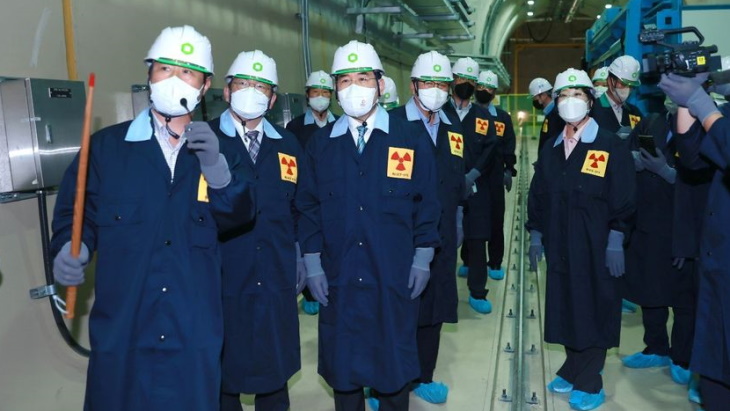A groundbreaking ceremony has been held to mark the start of construction of the second phase near-surface disposal facilities for low- and intermediate-level radioactive waste at Gyeongju in South Korea's North Gyeongsang province.

Trade, Industry and Energy Minister Lee Chang-yang was shown around the first phase facilities at Gyeongju (Image: MOTIE)
The Korea Radioactive Waste Agency (KORAD) applied in 2015 for a construction permit for the second phase of the facility, which will comprise near-surface disposal facilities for low-level radioactive waste (LLW), with the capacity to handle 1,250,000 200-litre drums of waste. The project, covering an area of some 120,000 square metres, is expected to cost KRW262.1 billion (USD195 million), with completion scheduled for 2024.
The construction of the second phase of the Gyeongju facility was approved by the Ministry of Trade, Industry and Energy (MOTIE) in July 2016. The Nuclear Safety and Security Commission (NSSC) granted a construction permit for the facilities in July this year.
A groundbreaking ceremony was held on 26 August, which was attended by Trade, Industry and Energy Minister Lee Chang-yang as well as representatives from companies including Korea Hydro & Nuclear Power, KEPCO E&C and Daewoo E&C.
Lee said that the second stage near-surface disposal system for LLW and intermediate-level (ILW) will be built with utmost priority on citizens' safety. He added that as much as the present generation has benefited from the development of nuclear energy, it is equally their duty to tackle the issues regarding high-level radioactive waste (HLW) and its disposal facilities.
The minister said there are plans to legislate special laws on the management of HLW and to establish an R&D technology roadmap.
The site selection process for the KRW1.56 trillion (USD1.5 billion) disposal facility began in 1986, eight years after South Korea's first nuclear power reactor - Kori unit 1 - began operating. Construction of the first phase of the repository started in early 2006 and was completed in June 2014. That phase consists of six underground silos, each 40 metres high and with a diameter of about 24 metres. This first phase can hold up to 100,000 barrels of ILW.
The NSSC gave approval in December 2014 for full operation to begin at the facility's first phase. The first waste - 16 drums of ILW waste within a concrete disposal container - were put within one of the facility's silos in July 2015.
Ultimately, the Gyeongju facility will be used to dispose of a total of 800,000 barrels of waste.
LLW is typically composed of, for example, clothes, filters, and equipment used routinely at nuclear sites. It is usually placed in drums that are then compacted. ILW contains, for example, resins, chemical sludges and metal fuel claddings which have higher levels of radioactivity and require shielding.
Researched and written by World Nuclear News